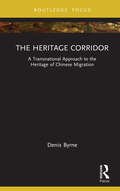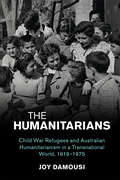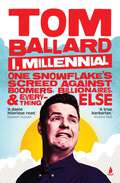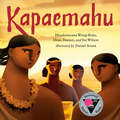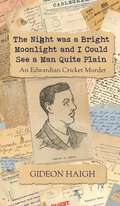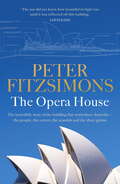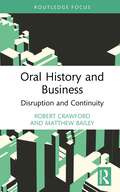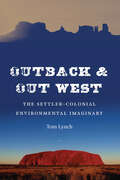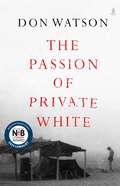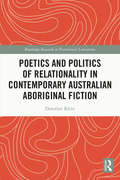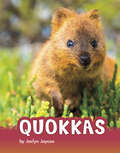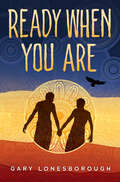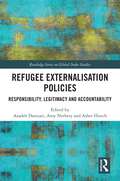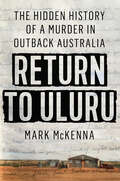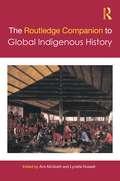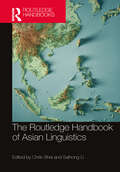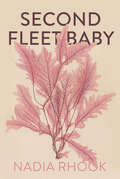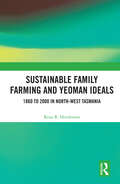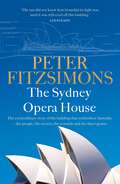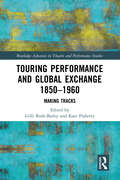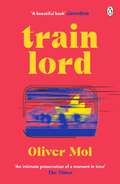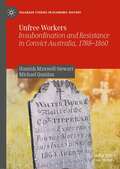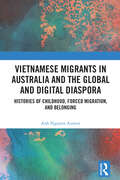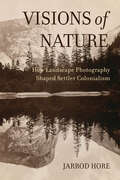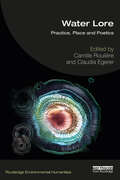- Table View
- List View
The Heritage Corridor: A Transnational Approach to the Heritage of Chinese Migration (Routledge Research on Museums and Heritage in Asia)
by Denis ByrneThe Heritage Corridor argues for a transnational approach to investigating and recording heritage places that emerge from histories of migration. Addressing the material legacy of migration, this book also relates it to issues of contemporary importance. Presenting an image of the built environment of migration as one shaped by the ongoing flows of people, ideas, objects and money that circulate through migration corridors, Byrne proposes that houses and other structures built by migrants in their home villages in China over the period 1840–1940 should be seen as crystallisations of the labour, aspirations and longings enacted and experienced by their builders while overseas. Demonstrating that the material world of the migrant is distributed across transnational space, the book calls for an approach to the heritage of migration that is similarly expansive. It proposes and illustrates new methods and strategies for heritage practice. The Heritage Corridor is a book for scholars and students in the fields of critical heritage studies, migration studies and Chinese diasporic mobilities. It is designed to be accessible to heritage practitioners, readers with an interest in the material worlds of migration, past and present, and to all those with an interest in the ‘archaeology’ of transnational migration.
The Humanitarians: Child War Refugees and Australian Humanitarianism in a Transnational World, 1919–1975 (Studies in the Social and Cultural History of Modern Warfare)
by Joy DamousiSpanning six decades from the formation of the Save the Children Fund in 1919 to humanitarian interventions during the Vietnam War, The Humanitarians maps the national and international humanitarian efforts undertaken by Australians on behalf of child refugees. In this longitudinal study, Joy Damousi explores the shifting forms of humanitarian activity related to war refugee children over the twentieth century, from child sponsorship, the establishment of orphanages, fundraising, to aid and development schemes and campaigns for inter-country adoption. Framed by conceptualisations of the history of emotions, and the limits and possibilities afforded by empathy and compassion, she considers the vital role of women and includes studies of unknown, but significant, women humanitarian workers and their often-traumatic experience of international humanitarian work. Through an examination of the intersection between racial politics and war refugees, Damousi advances our understanding of humanitarianism over the twentieth century as a deeply racialised and multi-layered practice.
I, Millennial: One Snowflake's Screed Against Boomers, Billionaires and Everything Else
by Tom Ballard&‘A damn hilarious read.&’ Nazeem Hussain &‘A true barbarian.&’ Andrew Bolt Our world is in chaos lol. And no, Australian Millennials, it&’s not your imagination: things are especially f**ked for us. Millions of Baby Boomers got beach houses, free education, jobs for life and a franking credit-fed retirement. But Millennials have been handed a housing crisis, crippling student debt, the gig economy, a cooked planet, a truly broken political system and now wars, inflation and a global pandemic, as a treat.This fully sucks. But never fear – this book is going to fix everything. Through the power of jokes, history, interviews and sass, so-called comedian Tom Ballard unpicks how his generation got here, and explains why we should probably do a revolution. Fact-filled and furiously funny, this is a must-read not just for young people wondering why they&’ve been given such a raw deal, but for anyone with an interest in how we&’re making our collective future impossible. &‘Tom Ballard is one of the most original, fearless and hilarious voices in Australian comedy.&’ Wil Anderson &‘As a fellow beleaguered Millennial, Tom is exactly the voice we need in this time of wailing capitalist death throes. Funny but biting, he lays out how the system has screwed us all – and it has nothing to do with avocado toast. You&’ll never be able to afford a house, so spend your money on this book instead.&’ Amy Remeikis &‘Ballard is fuming, funny, and armed with facts.&’ Tom Tilley &‘Speaking as Tom&’s non-biological mother, I am naturally proud to bursting of everything he does, especially the gay sex and particularly the class consciousness, which you will find emerging in this book.&’ Helen Razer &‘Tom makes me laugh, and think. I&’m not sure in which order. This book might be his last but that&’s ok – he&’s nailed it.&’ Dave Hughes
Kapaemahu
by Hinaleimoana Wong-Kalu Dean Hamer Joe WilsonAn Indigenous legend about how four extraordinary individuals of dual male and female spirit, or Mahu, brought healing arts from Tahiti to Hawaii, based on the Academy Award–contending short film. In the 15th century, four Mahu sail from Tahiti to Hawaii and share their gifts of science and healing with the people of Waikiki. The islanders return this gift with a monument of four boulders in their honor, which the Mahu imbue with healing powers before disappearing. As time passes, foreigners inhabit the island and the once-sacred stones are forgotten until the 1960s. Though the true story of these stones was not fully recovered, the power of the Mahu still calls out to those who pass by them at Waikiki Beach today. With illuminating words and stunning illustrations by Hinaleimoana Wong-Kalu, Dean Hamer, Joe Wilson, and Daniel Sousa, KAPAEMAHU is a monument to an Indigenous Hawaiian legend and a classic in the making.
The Night was a Bright Moonlight and I Could See a Man Quite Plain: An Edwardian Cricket Murder
by Gideon HaighGideon Haigh has written numerous acclaimed books on both cricket and true-crime – now he&’s unearthed a gripping story that combines the two, in a masterpiece of historical detective work that ties back to the origin of the Ashes … On the night of 23 September 1910, on a station 500km west of Brisbane, farm hand John Neil was beaten to death with a cricket bat. The prime suspect, George Vernon, was the fresh-faced twenty-four-year-old son of one of England&’s most famous amateur cricketers, and part of an Australian rural dynasty. The murder trial became one of Queensland&’s most sensational, for Vernon did indeed harbour a secret – but not a secret anyone suspected. And the crime was to have a shocking sequel. The Night was a Bright Moonlight and I Could See a Man Quite Plain concerns a brutal murder, but also the dark parts of empire, the blind side of justice and the sensational end of media – all linked back to the origin story of cricket&’s Ashes. Sparely written and copiously illustrated, it will keep you guessing to the end.
The Opera House: The extraordinary story of the building that symbolises Australia — the people, the secrets, the scandals and the sheer genius
by Peter FitzSimons'The sun did not know how beautiful its light was until it was reflected off this building.' - Louis Kahn, US architect If only these walls and this land could talk ... The Sydney Opera House is a breathtaking building, recognised around the world as a symbol of modern Australia. Along with the Taj Mahal and other World Heritage sites, it is celebrated for its architectural grandeur and the daring and innovation of its design. It showcases the incomparable talents involved in its conception, construction and performance history. But this stunning house on Bennelong Point also holds many secrets and scandals. In his gripping biography, Peter FitzSimons marvels at how this magnificent building came to be, details its enthralling history and reveals the dramatic stories and hidden secrets about the people whose lives have been affected, both negatively and positively, by its presence. He shares how a conservative 1950s state government had the incredible vision and courage to embark on this nation-defining structure; how an architect from Denmark and construction workers from Australia and abroad invented new techniques to bring it to completion; how ambition, betrayal, professional rivalry, sexual intrigue, murder, bullying and breakdowns are woven into its creation; and how it is now acknowledged as one of the wonders and masterpieces of human ingenuity. In The Opera House, Peter FitzSimons captures the extraordinary stories around this building that are as mesmerising as the light catching on its white sails.
Oral History and Business: Disruption and Continuity
by Robert Crawford Matthew BaileyThis book introduces business historians to oral history methodologies and approaches. Using four distinct oral history case studies to explore ideas of disruption and continuity in business history over the second half of the twentieth century, Robert Crawford and Matthew Bailey demonstrate how critical engagement with oral history approaches serves to enhance and enliven business history as well as its relationship with other historical fields. The focus on disruption is used to encompass a broad set of processes such as technological change, the impact of external forces, informal business networks, social constructions of gender, knowledge transfer, firm adaptability and cultural change. The use of oral histories to interpret responses to disruption in the past, and to explore the features characterising business continuity, provides an opportunity to consider the human dimensions, subjective experiences and personal insights of workplace, firm and industry change. It also sheds light on the ways that people and firms respond to disruptive forces through innovation and adaptation – both successfully and unsuccessfully. This succinct and accessible account is essential reading for business historians with little experience in using oral history, as well as those looking to gain deeper insights from their oral history data.
Outback and Out West: The Settler-Colonial Environmental Imaginary
by Tom LynchOutback and Out West examines the ecological consequences of a settler-colonial imaginary by comparing expressions of settler colonialism in the literature of the American West and Australian Outback. Tom Lynch traces exogenous domination in both regions, which resulted in many similar means of settlement, including pastoralism, homestead acts, afforestation efforts, and bioregional efforts at &“belonging.&” Lynch pairs the two nations&’ texts to show how an analysis at the intersection of ecocriticism and settler colonialism requires a new canon that is responsive to the social, cultural, and ecological difficulties created by settlement in the West and Outback.Outback and Out West draws out the regional Anthropocene dimensions of settler colonialism, considering such pressing environmental problems as habitat loss, groundwater depletion, and mass extinctions. Lynch studies the implications of our settlement heritage on history, art, and the environment through the cross-national comparison of spaces. He asserts that bringing an ecocritical awareness to settler-colonial theory is essential for reconciliation with dispossessed Indigenous populations as well as reparations for ecological damages as we work to decolonize engagement with and literature about these places.
The Passion of Private White
by Don WatsonFrom the bestselling author of The Bush, the story of a fifty-year relationship between a Vietnam veteran and an isolated clan in north-east Arnhem Land – a unique window into Australia&’s deep past and precarious present, by one of our master storytellers.The Passion of Private White describes the meeting of two worlds: that of the intensely driven anthropologist Neville White, and the world of hunter-gatherer clans in remote northern Australia with whom he has lived and worked for half a century, mapping their culture and history in breathtaking detail. As White began to understand this ancient culture struggling between the demands of Western modernity and the equally pressing need to preserve their lands, customs, laws and language, he was also trying to transcend the mental scars inflicted on the battlefields of Vietnam. Eventually, scholarly observer crossed the line into activist, advocate and defender of the clans&’ effort to create a safe and healthy homeland, a seat both of traditional culture and contemporary skills and education. The enterprise meant overcoming everything from insatiable mining companies and official incompetence and neglect, to customs that were fundamental in the old way of life but dysfunctional in the transition to the new. When White began taking his old platoon mates to the homeland, two wildly different groups found in each other some of the solutions and some of the therapy they both needed. Don Watson has had his own fifty-year relationship with Neville White, since meeting him as an undergraduate in Melbourne. This book is the result: moving, enlightening, devastating and inspiring, it is a towering achievement, a profound insight into both our recent and our deep history, the coloniser and colonised – indeed into the human condition itself.
Poetics and Politics of Relationality in Contemporary Australian Aboriginal Fiction (Routledge Research in Postcolonial Literatures)
by Dorothee KleinPoetics and Politics of Relationality in Contemporary Australian Aboriginal Fiction is the first sustained study of the formal particularities of works by Bruce Pascoe, Kim Scott, Tara June Winch, and Alexis Wright. Drawing on a rich theoretical framework that includes approaches to relationality by Aboriginal thinkers, Edouard Glissant, and Jean-Luc Nancy, and recent work in New Formalism and narrative theory, it illustrates how they use a broad range of narrative techniques to mediate, negotiate, and temporarily create networks of relations that interlink all elements of the universe. Through this focus on relationality, Aboriginal writing gains both local and global significance. Locally, these narratives assert Indigenous sovereignty by staging an unbroken interrelatedness of people and their Land. Globally, they intervene into current discourses about humanity’s relationship with the natural environment, urging readers to acknowledge our interrelatedness with and dependence on the land that sustains us.
Quokkas (Animals)
by Jaclyn JaycoxQuokkas might be the cutest animals you’ve never heard of. These furry little creatures look like a cross between a kangaroo and a squirrel. Get fun details about this adorable Australian animal.
Ready When You Are
by Gary LonesboroughA remarkable YA love story between two Aboriginal boys -- one who doesn't want to accept he's gay, and the boy who comes to live in his house who makes him realize who he is.It's a hot summer, and life's going all right for Jackson and his family on the Mish. It's almost Christmas, school's out, and he's hanging with his mates, teasing the visiting tourists, and avoiding the racist boys in town. Just like every year, Jackson's Aunty and annoying little cousins visit from the city -- but this time a mysterious boy with a troubled past comes with them. As their friendship evolves, Jackson must confront the changing shapes of his relationships with his friends, family, and community. And he must face his darkest secret -- a secret he thought he'd locked away for good.
Refugee Externalisation Policies: Responsibility, Legitimacy and Accountability (Routledge Series on Global Order Studies)
by Azadeh DastyariThis book examines the impact and effects of refugee externalisation policies in two regions: Australia’s border control practices in Southeast Asia and the Pacific and the activities of the European Union and its member states in North Africa. The book assesses the underlying motivations, processes, policy frameworks, and human rights violations of refugee externalisation practices. Case studies illuminate the funding, institutional partnerships, geopolitical impacts, financial costs, and the human price of refugee externalisation. It provides the first truly comparative analysis of asylum externalisation and explores maritime interdiction, extraterritorial process, containment and third-country interception, and communication campaigns in Southeast Asia and the Middle East/North Africa. This book will be of key interest to scholars and students of refugee and asylum studies, law, politics, and the arts, legal practitioners, non-government organisations, and policymakers grappling with the issues of detention, refugee externalisation practices, and the growing need to find safety for the world’s most vulnerable.
Return to Uluru: The Hidden History of a Murder in Outback Australia
by Mark McKenna"THIS WEEK'S HOTTEST NEW RELEASES: Murder befouls the outback... [A] gripping work of true crime." —USA TODAYReturn to Uluru explores a cold case that strikes at the heart of white supremacy—the death of an Aboriginal man in 1934; the iconic life of a white, "outback" police officer; and the continent's most sacred and mysterious landmark.Inside Cardboard Box 39 at the South Australian Museum&’s storage facility lies the forgotten skull of an Aboriginal man who died eighty-five years before. His misspelled name is etched on the crown, but the many bones in boxes around him remain unidentified. Who was Yokununna, and how did he die? His story reveals the layered, exploitative white Australian mindset that has long rendered Aboriginal reality all but invisible. When policeman Bill McKinnon&’s Aboriginal prisoners escape in 1934, he&’s determined to get them back. Tracking them across the so called "dead heart" of the country, he finds the men at Uluru, a sacred rock formation. What exactly happened there remained a mystery, even after a Commonwealth inquiry. But Mark McKenna&’s research uncovers new evidence, getting closer to the truth, revealing glimpses of indigenous life, and demonstrating the importance of this case today. Using McKinnon&’s private journal entries, McKenna paints a picture of the police officer's life to better understand how white Australians treat the center of the country and its inhabitants. Return to Uluru dives deeply into one cold case. But it also provides a searing indictment of the historical white supremacy still present in Australia—and has fascinating, illuminating parallels to the growing racial justice movements in the United States.
The Routledge Companion to Global Indigenous History (Routledge Companions)
by Ann McGrath Lynette RussellThe Routledge Companion to Global Indigenous History presents exciting new innovations in the dynamic field of Indigenous global history while also outlining ethical, political, and practical research. Indigenous histories are not merely concerned with the past but have resonances for the politics of the present and future, ranging across vast geographical distances and deep time periods. The volume starts with an introduction that explores definitions of Indigenous peoples, followed by six thematic sections which each have a global spread: European uses of history and the positioning of Indigenous people as history’s outsiders; their migrations and mobilities; colonial encounters; removals and diasporas; memory, identities, and narratives; deep histories and pathways towards future Indigenous histories that challenge the nature of the history discipline itself. This book illustrates the important role of Indigenous history and Indigenous knowledges for contemporary concerns, including climate change, spirituality and religious movements, gender negotiations, modernity and mobility, and the meaning of ‘nation’ and the ‘global’. Reflecting the state of the art in Indigenous global history, the contributors suggest exciting new directions in the field, examine its many research challenges and show its resonances for a global politics of the present and future. This book is invaluable reading for students in both undergraduate and postgraduate Indigenous history courses.
The Routledge Handbook of Asian Linguistics
by Chris Shei Saihong LiThe Routledge Handbook of Asian Linguistics provides a comprehensive overview of the ways in which Asian languages should be conceptualized as a whole, the distinct characteristics of each language group, and the relationships and results of interactions between the languages and language families in Asia. Asia is the largest and the most populous continent on Earth, and the site of many of the first civilizations. This Handbook aims to provide a systematic overview of Asian languages in both theoretical and functional perspectives, optimally combining the two in intercultural settings. In other words, the text will provide a reference for researchers of individual Asian languages or language groups against the background of the entire range of Asian languages. Not only does the Handbook act as a reference to a particular language, it also connects each language to other Asian languages in the perspective of the entire Asian continent. Cultural roles and communicative functions of language are also emphasized as an important domain where the various Asian languages interact and shape each other. With extensive coverage of both theoretical and applied linguistic topics, The Routledge Handbook of Asian Linguistics is an indispensable resource for students and researchers working in this area.
Second Fleet Baby
by Nadia RhookSecond Fleet Baby examines birth and motherhood, drawing on the playful energies and powers of 18th and 19th century ‘convict chicks', including Rhook's own ancestor, who was transported from England to Eora land on the Lady Juliana as part of the notorious 1789 Second Fleet.How might a settler reconcile the violence bound up with their role populating stolen land with the love and euphoria that can flow from parenthood? Intergenerational ties are traced through the soft weapons of the body, connecting the intimacies of nation-making with the politics of reproduction in lavishly personal ways.
Sustainable Family Farming and Yeoman Ideals: 1860 to 2000 in North-West Tasmania
by Rena R. HendersonWithin the frame of family farming, this book offers a longitudinal study of the Castra district in North-West Tasmania from first European settlement to the end of the twentieth century. It draws upon historical sources for yeomanry characteristics from Britain, Canada, the USA, New Zealand and Australian mainland colonies to show how these characteristics were persistently supportive of family farming. Surveying farming communities over several generations, this book explores a range of topics including colonial surveying practices, settler families’ motivation, attributes and demographics, the role of Methodism, the ways children were inculcated into yeoman farming enterprises, the role of women as companionate wives, and the political participation of farmers in the public sphere. The book also offers a new perspective of three commonly-held myths of settlement failure: the settlement of retired Anglo-Indian military and civil officers in the 1870s, the settlement of soldiers on small farms after the Great War, and the claims that the ideal of yeoman family farming was anachronistic to capitalist commodity production. The book draws from a wide selection of previously underused primary source materials, including oral histories from current and past residents, to provide a comprehensive overview of an important aspect of rural Australian history.The book is a valuable contribution to Australian historiography, and will be a useful resource for students and scholars of rural history, social history, environmental history, colonialism and sustainable agriculture.
The Sydney Opera House
by Peter FitzSimonsIf only these walls and this land could talk . . . The Sydney Opera House is a breathtaking building, recognised around the world as a symbol of modern Australia. Along with the Taj Mahal and other World Heritage sites, it is celebrated for its architectural grandeur and the daring and innovation of its design. It showcases the incomparable talents involved in its conception, construction and performance history. But this stunning house on Bennelong Point also holds many secrets and scandals. In his gripping biography, Peter FitzSimons marvels at how this magnificent building came to be, details its enthralling history and reveals the dramatic stories and hidden secrets about the people whose lives have been affected, both negatively and positively, by its presence. He shares how a conservative 1950s state government had the incredible vision and courage to embark on this nation-defining structure; how an architect from Denmark and construction workers from Australia and abroad invented new techniques to bring it to completion; how ambition, betrayal, professional rivalry, sexual intrigue, murder, bullying and breakdowns are woven into its creation; and how it is now acknowledged as one of the wonders and masterpieces of human ingenuity.
Touring Performance and Global Exchange 1850-1960: Making Tracks (Routledge Advances in Theatre & Performance Studies)
by Gilli Bush-BaileyThis collection uncovers connections and coincidences that challenge the old stories of pioneering performers who crossed the Atlantic and Pacific oceans from the mid-nineteenth to the mid-twentieth century. This book investigates songlines, drama, opera, music theatre, dance, and circus—removing traditional boundaries that separate studies of performance, and celebrating difference and transformation in style, intention, and delivery. Well known, or not known at all, travelling performers faced dangers at sea and hazardous journeys across land. Their tracks, made in pursuit of fortune and fame, intersected with those made by earlier storytellers in search for food. Making Tracks takes a fresh look at such tracks—the material remains—demonstrating that moving performance does far more than transfer repertoires and people; it transforms them. Touring performance has too often been conceived in diasporic terms, as a fixed product radiating out from a cultural centre. This collection maps different patterns—ones that comprise reversed flows, cross currents, and continually proliferating centres of meaning in complex networks of global exchange. This collection will be of great interest to scholars and students in theatre, music, drama studies and cultural history.
Train Lord: The Astonishing True Story of One Man's Journey to Getting His Life Back On Track
by Oliver MolThe astonishing true story of trust, pain, becoming lost, and finding a way back to yourself despite it all'An intimate preservation of a moment in time, full of personality' THE TIMES__________Life is beautiful - even in the dark . . .Oliver Mol was happily drifting through his twenties when the migraine exploded in his head.Suddenly, he could barely function. He felt marooned. Nothing helped. Yet he was desperate to save himself.Then he found the trains. The job of train guard has intense moments of strict, regimented activity in between periods of calm serenity. It was just what Oliver needed. Not only could he do this, but also it might be a way out.Train Lord is the story of Oliver's extraordinary recovery. A journey back into the light . . .__________'Tender, vital and quietly hopeful: a tale of remaking' Guardian'Rude, raw, visceral, painful and wildly funny' Saga 'Intense and humble, Train Lord won my heart' Australian Book Review
Unfree Workers: Insubordination and Resistance in Convict Australia, 1788-1860 (Palgrave Studies in Economic History)
by Michael Quinlan Hamish Maxwell-StewartThis book examines how convicts played a key role in the development of capitalism in Australia and how their active resistance shaped both workplace relations and institutions. It highlights the contribution of convicts to worker mobilization and political descent, forcing a rethink of Australia’s foundational story. It is a book that will appeal to an international audience, as well as the many hundreds of thousands of Australians who can trace descent from convicts. It will enable the latter to make sense of the experience of their ancestors, equipping them with the necessary tools to understand convict and court records. It will also provide a valuable undergraduate and postgraduate teaching tool and reference for those studying unfree labour and worker history, social history, colonization and global migration in a digital age.
Vietnamese Migrants in Australia and the Global Digital Diaspora: Histories of Childhood, Forced Migration, and Belonging
by Anh Nguyen AustenThrough oral histories, memoirs, and Facebook posts of Vietnamese adults who entered Australia as children after the Vietnam War (and Vietnamese refugees, war orphans, and children of refugees) this book provides insight into the memories of forced migrant childhoods and histories, as well as the complexities of national and transnational identity and belonging in digital diaspora. As war and displacement compounds the need for creating communities and histories for cultural continuity, this book is a history about childhood and migration for the Vietnamese diaspora of refugees, adoptees, and second generation in Australia and their connectedness to a global and digital diaspora. Using Facebook as a digital archive for historical research, Vietnamese Migrants in Australia and the Global Digital Diaspora presents new methods for the study of what Nguyen Austen proposes as a new area of digital diaspora studies for interdisciplinary research about real and digital life in the humanities and social sciences. As a contemporary digital diaspora study of Vietnamese forced child migrants from 1975 to the present, this book contains a mixed-methods historical analysis of the impact of war and displacement on memories of childhood. This book presents an innovative history of the national, transnational, digital, and contemporaneous lives of Vietnamese child migrants, which will make a significant contribution to the discourse on transnational childhood, migration, and belonging for refugees and migrants in the twenty-first century.
Visions of Nature: How Landscape Photography Shaped Settler Colonialism
by Dr. Jarrod HoreVisions of Nature revives the work of late nineteenth-century landscape photographers who shaped the environmental attitudes of settlers in the colonies of the Tasman World and in California. Despite having little association with one another, these photographers developed remarkably similar visions of nature. They rode a wave of interest in wilderness imagery and made pictures that were hung in settler drawing rooms, perused in albums, projected in theaters, and re-created on vacations. In both the American West and the Tasman World, landscape photography fed into settler belonging and produced new ways of thinking about territory and history. During this key period of settler revolution, a generation of photographers came to associate "nature" with remoteness, antiquity, and emptiness, a perspective that disguised the realities of Indigenous presence and reinforced colonial fantasies of environmental abundance. This book lifts the work of these photographers out of their provincial contexts and repositions it within a new comparative frame.
Water Lore: Practice, Place and Poetics (Routledge Environmental Humanities)
by Camille Roulière Claudia EgererLocated within the field of environmental humanities, this volume engages with one of the most pressing contemporary environmental challenges of our time: how can we shift our understanding and realign what water means to us? Water is increasingly at the centre of scientific and public debates about climate change. In these debates, rising sea levels compete against desertification; hurricanes and floods follow periods of prolonged drought. As we continue to pollute, canalise and desalinate waters, the ambiguous nature of our relationship with these entities becomes visible. From the paradisiac and pristine scenery of holiday postcards through to the devastated landscapes of post-tsunami news reports, images of waters surround us. And while we continue to damage what most sustains us, collective precarity grows. Breaking down disciplinary boundaries, with contributions from scholars in the visual arts, history, earth systems, anthropology, architecture, literature and creative writing, archaeology and music, this edited collection creates space for less-prominent perspectives, with many authors coming from female, Indigenous and LGBTQIA+ contexts. Combining established and emerging voices, and practice-led research and critical scholarship, the book explores water across its scientific, symbolic, material, imaginary, practical and aesthetic dimensions. It examines and interrogates our cultural construction and representation of water and, through original research and theory, suggests ways in which we can reframe the dialogue to create a better relationship with water sources in diverse contexts and geographies. This expansive book brings together key emerging scholarship on water persona and agency and would be an ideal supplementary text for discussions on the blue humanities, climate change, environmental anthropology and environmental history.
